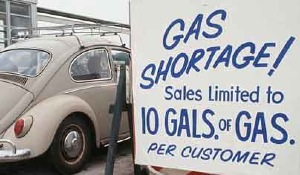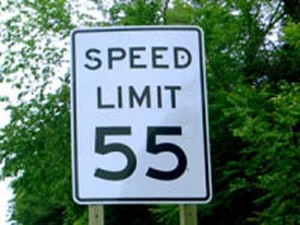 Thirty-five years ago, the U.S. government enacted the Corporate Average Fuel Economy (CAFE) standards to improve the average fuel economy of cars and trucks sold in the U.S.
Thirty-five years ago, the U.S. government enacted the Corporate Average Fuel Economy (CAFE) standards to improve the average fuel economy of cars and trucks sold in the U.S.
The legislation came after several events – most notably the oil embargo of 1973, which drove up pump prices for gas, which in turn drove U.S. drivers to anger – caused the automotive industry to do an about face in regards to vehicle fuel efficiency. Up to the early 1970s, vehicles manufactured and/or sold in the U.S. were, by any measure, large, powerful, heavy and thirsty for fuel.
The October 1973 oil crisis began when members of OPEC (and the oil-producing countries of Egypt, Syria and Tunisia) placed an embargo on oil to the U.S. as foreign policy retribution. There was some bad blood between the U.S. and Arab nations, in part because of the U.S.’s decision to re-supply the Israeli military during the Yom Kippur war. The embargo continued through the winter of 1973 and finally ended the following spring, in March 1974.
The embargo had broad, sweeping effects on global oil supplies, prices and rationing, which trickled down into nearly every facet of the U.S. economy. Oil prices skyrocketed four-fold to nearly $12 U.S. per barrel by 1974. Oil-producing nations that supplied the West with the commodity accumulated wealth at an increased rate, with some of that money going into armament – increasing tensions between the West and Middle Eastern nations involved in the crisis.
The embargo and the resultant cutbacks in the amount of oil OPEC nations were willing to sell to the West drove demand higher, while available supplies decreased to European Common Market countries and Japan.
Eventually, a 25% drop in oil production was realized, limiting supplies to these nations – which affected policy on micro and macro levels. In the U.S., “energy security” became of utmost importance, and internationally, petroleum price increases altered competitive situations in the marketplace and disrupted systems on a huge scale.
The embargo wreaked havoc in the U.S., the U.K., West Germany, Switzerland, Norway and the Netherlands. Flying, driving and boating were banned on Sundays in many nations, Christmas lights were banned in Oregon, and a national 55 mph speed limit was imposed in 1974 thanks to the Emergency Highway Energy Conservation Act.
In 1975, the U.S. Strategic Petroleum Reserve was created, and in 1977 the U.S. Department of Energy became a Cabinet-level post. By 1980, the size of American vehicles had decreased dramatically, and the giant, gas-gulping V8, rear-wheel drive cars were being replaced by smaller, more fuel-efficient front-wheel-drive V6 and four-cylinder cars.
Bias-ply tires eventually made way for steel-belted radials, and high-performance, low profile tires (75-series!) were born – augmenting the handling characteristics of the lighter, less powerful cars of the day. 
Much of the drive toward automaker innovation in fuel-miserly vehicles was a direct result of the federal government’s new-for-1975 CAFE standards. The standards were enacted by Congress to improve the average fuel economy of cars and light trucks sold in the U.S., thereby (they thought) lowering our dependence on “foreign oil.”
Manufacturers of vehicles offered for sale in the U.S. (cars and light trucks, including pick-ups, vans, SUVs and crossovers with a gross vehicle weight of 8,500 pounds or less qualify) have their fleet’s fuel economy tested by the EPA, with each vehicle contributing its average miles per gallon to the OEM’s “harmonic mean” to achieve the fleet’s total mpg status.
The harmonic mean captures the fuel economy of each OEM’s passenger vehicle driven for the same number of miles, which differs from an arithmetic mean, which measures the fuel economy of each car using the same amount of fuel (i.e. the 25 mpg vehicle would travel 25 miles with one gallon of gas while the 100 mpg vehicle would travel 100 miles.)
Each manufacturer’s vehicle output is divided into its domestic fleet (vehicles with more than 75% U.S., Canadian or post-NAFTA Mexican content) and its foreign fleet (all other vehicles), and both must meet the CAFE requirements.
Trucks have been exempt from the two-fleet measurement since 1996. The United Automobile Workers union developed the two-fleet idea to create/maintain jobs in the U.S.
The Department of Transportation’s National Highway Traffic Safety Administration administers CAFE standards, and the EPA is responsible for measuring vehicle fuel efficiency. Tricky business for sure – however, Congress specified that CAFE standards must be set at the “maximum feasible level” given consideration for technical feasibility, economic practicality, the effect of other standards on fuel economy and the need of the U.S. to conserve energy.
Shifting Standards
In addition to CAFE’s stated goal of increasing average fuel economy across an OEM’s saleable fleet, the Obama administration has also tasked the OEMs with reducing the CO2 output of the fleet.
In the most sweeping changes since the inception of CAFE standards, last year President Obama stated that both agencies (DOT and EPA) will cooperate on a uniform average at the state and federal levels that will increase CAFE standards over time and reduce greenhouse gas emissions.
As a result, OEMs will have to improve fuel economy for cars from the current levels (in place since 1990) of 27.5 mpg to 37.8 mpg by 2016. Light trucks must see an increase from 23.5 mpg to 28.8 mpg.
OEMs will have to find significant fuel savings – adding up to a combined 35% increase overall, or 5.1% per year.
To understand where those gains in fuel economy will come from, it is important to understand what tools the OEMs have to meet the increases.
Since CAFE standards had not changed since 1990, the potential for increases in corporate average fuel economy have outpaced the regulations. In the past 20 years, the automotive industry has seen developments in efficiencies on many levels.
Computerized engine controls, materials usage, weight, power and reduced rolling resistance of vehicle tires all factored into fuel economy gains.
With a current CAFE fleet fuel economy average of 32.5 mpg, and a truck fleet average of 24.5 mpg, OEMs increased their CAFE mileage 5 mpg (car fleet) and 1 mpg (truck fleet) above the standard by the 2009 model year.
By reaching 2011 targets ahead of the game in fuel economy averages, OEMs can apply those gains to mileage credits that can be utilized at a later date to comply with the 5.1% per year increases required to meet the new 2016 standards of 37.8 mpg and 28.8 mpg for cars and trucks, respectively.
Alternative fuels also figure heavily into a fleet’s CAFE fuel mileage calculations. E85 has become increasingly popular around the world, and is an alcohol-fuel mixture that typically contains up to 85% denatured fuel ethanol and gasoline or other hydrocarbon by volume.
According to the Board on Energy and Environmental Systems’ journal article, “Effectiveness and Impact of Corporate Average Fuel Economy Standards” (2002), an E85-capable, or “dual fuel” vehicle is computed using the average of its alternative fuel rating – divided by 0.15 (or equal to multiplying by 6.666) – and its gasoline rating. Thus, “an E85-capable vehicle that gets 15 mpg on E85 and 25 mpg on gasoline would be computed as 100 mpg for E85 and the standard 25 mpg for gasoline, or, 62.5 mpg.”
Additionally, automakers will now be able to use the size of each vehicle in their fleet to the best advantage instead of only the size of its fleet.
For example: each vehicle’s fuel economy average will be calculated using the vehicle’s “footprint,” or total area, in square feet, measured by multiplying a vehicle’s wheelbase by its track. A larger footprint actually decreases the total percentage increase of fuel economy that vehicle must achieve. In basic terms, the smaller a vehicle’s footprint, the higher average fuel economy it must achieve, and vice versa.
According to Car & Driver magazine’s Csabe Csera, using the government’s new CAFE formula, “a current Ford Focus would have to achieve 40.8 mpg by 2016, while a Mercedes S-class will have a bogey of 31.8 mpg. Cars smaller than the Focus won’t be required to get better mileage.”
These increases in mileage are by no means a drop in the bucket, and automakers increasingly rely on their suppliers to develop more and more fuel-efficient products that will help them achieve their CAFE goals.
Fines for non-compliance are stiff – $5.50 per 0.1 mpg under the standard, multiplied by the manufacturer’s total production for the U.S. market.
Defeating the purpose entirely, several automakers selling vehicles in the U.S. have chosen to pay the fines in lieu of achieving the fuel mileage gains.
Tiremakers continue to innovate in the areas of reduced rolling resistance, lowered weight, and the use of more and more sustainable products and processes designed to increase fuel economy for vehicles and decrease environmental impact.
We’ll continue our look at CAFE standards and how they impact tires in the October issue of Tire Review.













